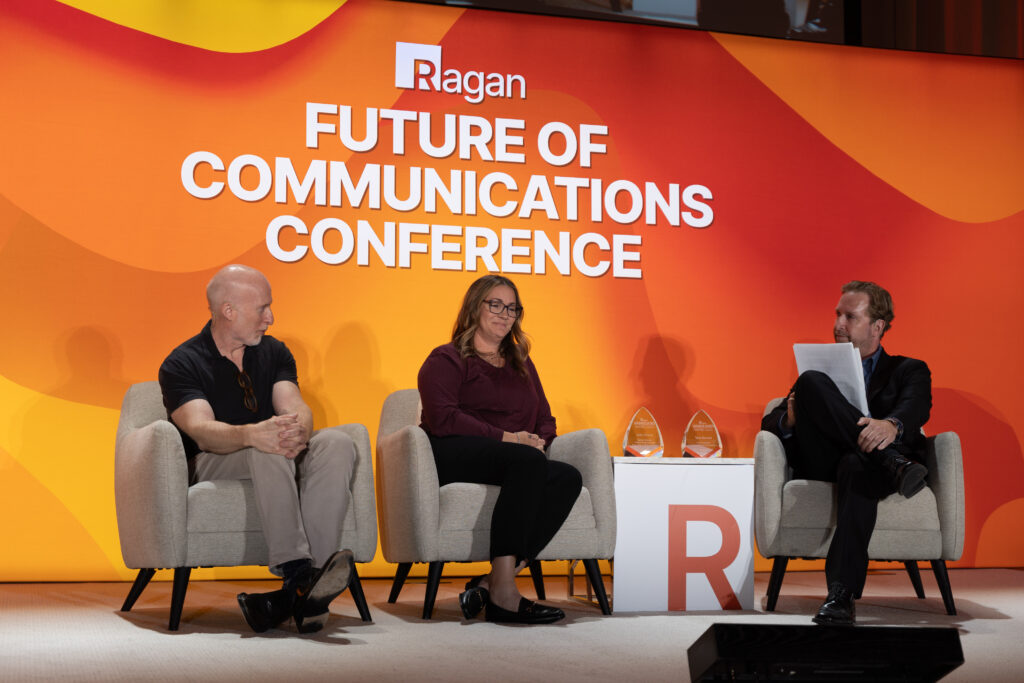Breaking through in 2025: Microsoft and T-Mobile leaders share CommsWeek takeaways
Microsoft’s John Cirone and T-Mobile’s Tara Darrow recap the lessons that stuck out at Ragan’s Future of Communications Conference 2024.

The challenges communicators face are growing more complex. Understanding how to address increasingly divided audiences, blurred lines between internal and external communications and integration of AI into workflows requires preparation, adaptation and the ability to build bridges.
These ideas were recurring themes at Ragan’s Future of Communications Conference, the flagship event of CommsWeek 2024.
During a webinar recapping takeaways from the event, Mike Prokopeak, director of learning and council content for Ragan’s Communications Leadership Council, spoke to two council members and winners of Ragan’s inaugural Vanguard Awards — John Cirone, senior director of global employee and executive communications at Microsoft, and Tara Darrow, vice president, corporate and financial communications, values and reputation and executive brand at T-Mobile — about the lessons that stuck with them.
Communications priorities in the new year
As organizations brace for 2025, communicators must focus on aligning with corporate priorities while embracing new tools and techniques. This means:
- Aligning communications with core business goals. This will require balancing internal and external messaging priorities while making room to try new things and innovate alongside new products and org structures.
- Dedicating time for experimentation with emerging tools like AI.
- “It’s about making AI a daily habit,” said Cirone. “Carving out space to experiment with tools like Copilot allows us to uncover ways to work smarter while staying aligned with the company’s priorities.”
- “AI streamlines the repetitive tasks so we can focus on higher value work that truly drives business outcomes,” Darrow agreed. “It takes the busy work off our plates.”
- Staying agile and anticipating external challenges.
- Darrow’s focus at T-Mobile is guided by a three-year strategic plan that emphasizes agility to fulfill a dual mission of both driving and transforming the business.
- Both leaders spoke to the urgency of being prepared for shifting regulatory environments and emerging social issues. “We need to be ready to engage where it matters most while staying true to our values as a company,” Darrow said.
Adapting to the ‘shattered glass’ media ecosystem
Both Darrow and Cirone agreed with the metaphor of today’s media landscape feeling like “shattered glass,” with news and information flowing from endless platforms, voices and nontraditional outlets like podcasts or Substack sites.
Navigating this will require:
- Integrating traditional and emerging media platforms into a cohesive, holistic strategy.
- Traditional PR methods like solely relying on press releases no longer cut it. Balancing an ever-expanding array of channels and platforms requires going where your intended audiences are most active in a way that feels like an authentic fit for the brand.
- “News is coming from everywhere—TikTok, Instagram, podcasts, social media and traditional outlets,” Darrow said. “This fragmentation forces us to integrate across platforms, from influencers to customer voices, in ways we hadn’t before.”
- Making sense of external messaging for internal audiences.
- As employees look for internal messaging to find clarity amid the noise, communicators become the translators of this ecosystem—and how their organization exists within it.
- “A decade ago, employees cited external sources as their most trusted information channels. Today, our internal channels dominate, which reflects a shift in how employees prioritize trusted communication from their organization,” said Cirone.
Addressing the internal-external overlap
Cirone’s point illustrates just one example where the line between internal and external communications blurs. When this happens, communicators must adapt their approaches to address changing employee demands. Employees can be your most vocal external stakeholders and move from advocate to activist pretty quickly when they feel unheard and unsupported—even amplifying internal messages on public platforms.
You can mitigate this by:
- Creating a messaging strategy that aligns internal and external narratives.
- “The internal world is the external world now, and vice versa,” said Darrow. “It’s critical to create cohesive messaging that reflects the nuances of both.”
- Training your comms team to approach each challenge with a holistic mindset.
- “Specialization can make it harder to see risks across the broader communication spectrum,” Cirone said. “We’re upskilling our teams to think holistically and consider multiple perspectives.”
Building bridges in a divided world
Communicators today serve as bridge builders, conveners and dot connectors who engage disparate and divided audiences through empathy and narrative.
This is made easier by:
- Using storytelling as a tool to connect and unify.
- Darrow believes that the power of words is strong enough to bring adversaries together. “Through storytelling, we help connect people across divides, shaping conversations in ways that resonate deeply with our audiences,” she said.
- Developing frameworks that identify and evaluate strategic engagement opportunities.
- T-Mobile’s “Lean Team” framework helps the comms team assess whether to lean into or out of conversations based on an established set of criteria.
- Grounding your comms strategies in data.
- Darrow emphasized that this framework is ultimately a data-driven exercise. “We rely on data to understand the value and risk of engagement, ensuring we’re present where it matters and silent when it’s best,” she explained.
- Cirone agreed and explained that data-driven decision-making moves the comms function from a tactical to a strategic place. “Communicators need to show their impact, not just their value, by grounding strategies in data and aligning them with organizational goals,” he said.
The future is unwritten
As communicators prepare for an uncertain future, there’s certainty in building skilled, diverse teams with the ability to navigate change.
“The impact of communications lies in its ability to drive change and act as a trusted advisor to leadership,” said Cirone. “Focus on building teams that complement your strengths and amplify your goals.”
Darrow agreed, boldfacing the idea that seeking alignment across stakeholders and staying agile will keep comms in the mix.
“If your feet are planted, you’re not contributing,” she said. “You have to keep moving, shifting and evolving to stay relevant.”
Register now to access the full, free webinar here.
Darrow and Cirone are both members of Ragan’s Communications Leadership Council. Learn more about joining here.







